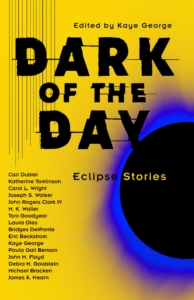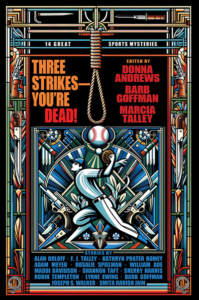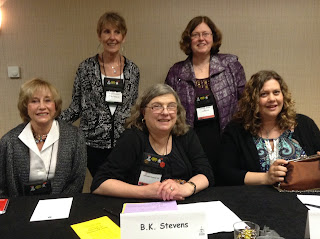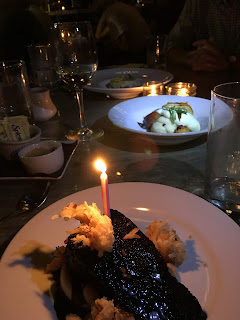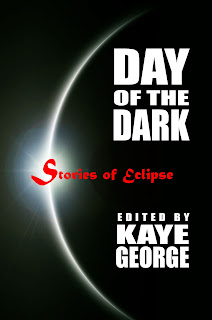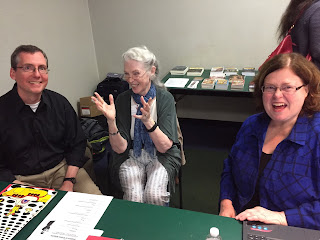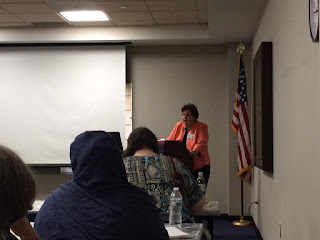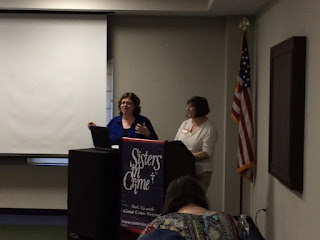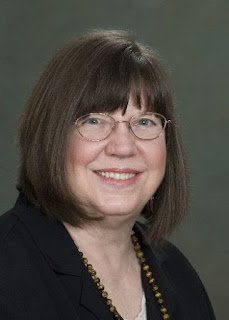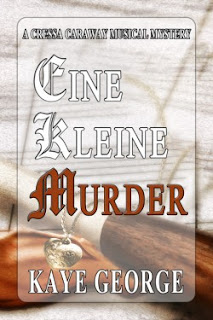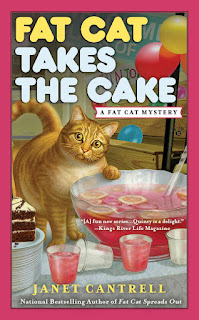by Paula Gail Benson
Each
year, it is such a delight for me to welcome the authors whose short stories
have been nominated for the Agatha award, presented at Malice Domestic. This
year, the event may have been postponed, but that’s no reason not to celebrate the authors and their nominated stories! These authors are not only expert at the craft of short story writing, but
also dear friends. Their nominated stories offer the depth and emotion that
fine storytelling always evokes. Please take time to read each of the stories at
the following links:
“The Blue
Ribbon” by Cynthia Kuhn in Malice
Domestic 14: Mystery Most Edible (Wildside Press)
“The Last
Word” by Shawn Reilly Simmons, Malice
Domestic 14: Mystery Most Edible (Wildside Press)
“Better
Days” by Art Taylor in Ellery
Queen Mystery Magazine
Welcome
Kaye, Barb, Cynthia, Shawn, and Art to the Stiletto Gang!
How do you decide the point of view or who
will tell your short story?
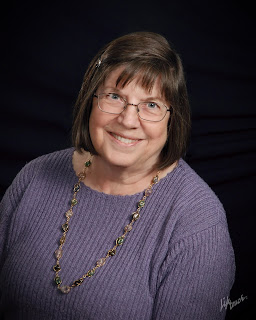 |
| Kaye George |
Kaye
George:
The
theme of the anthology was animal group names. You know, those odd ones, like a
Murder of Crows (not coincidentally, the name of the anthology)? I looked up a
bunch and discovered a Grist of Bees. I got the go-ahead to use that group and
so my MC had to be a beekeeper.
Barb
Goffman:
This
is usually an organic issue for me. I don’t come up with a plot and then think
about who would be the best person to tell the story. My stories are character
driven, so once I know a character’s story—his/her situation that I want to
tell—the point of view to use has already been decided. This was true of my
Agatha-nominated story “Alex’s Choice.” That said, sometimes for a story to
work, I need to tell it from multiple perspectives, so I do so. (You may be
thinking, stories with multiple POV from Barb? I don’t recall those stories.
That’s true. They haven’t been published—yet!)
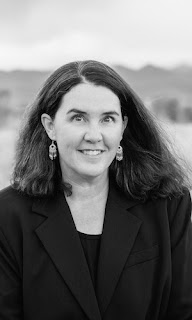 |
| Cynthia Kuhn |
Cynthia
Kuhn:
Seems
to depend on the story—some require access to the protagonist’s perspective and
some require more distance.
Shawn
Reilly Simmons:
For
me every story is different, but I do tend to focus on one POV of a character
with a strong motivation to move the story forward. For this particular story,
the character driving the story has a strong motivation to take inventory of
his friendship with one of his oldest acquaintances.
Art
Taylor:
I’ve used a variety of
points of view across my stories—both in terms of prose point-of-view (I, you,
he, she) and in terms of character (a detective’s perspective, a criminal’s,
whoever’s). The narrator of “Better Days” is a journalist who was downsized
from a major newspaper and has picked up a job at a small coastal North
Carolina newspaper—in the same town where his father now lives, father and son
both trying to build better relations in the years since the narrator’s mother
died. That father-son relationship is core to the story, and it was important
for me to show that relationship through the eyes of the son—both some of the
frustrations about the relationship and also some redemption too. While the
narrator sets out to investigate the crime here, the dad is the one who steps forward
as the detective solving the case—not quite a Watson-Sherlock relationship, but
certainly echoes of that, and there are many reasons that Watson is the
narrator of the Sherlock stories, of course.
Each of your stories take place in a
unique “universe” that becomes an important part of the plot. Which came first,
your characters or the setting, or, if they were somehow melded, how?
Kaye
George:
My
characters were first, and the setting is just their homes and yards in
Anywhere USA. I think people have backyard gardens and keep bees in a lot of
places, so I didn’t specify where it is, exactly. I’d love for the reader to
imagine this is their town.
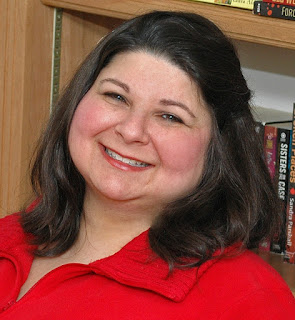 |
| Barb Goffman |
Barb
Goffman:
Combo
for me. Sometime in the year before I wrote my story, I read a newspaper
article about a tragedy involving a California family. They had been on the
beach, and after their dog went into the ocean and didn’t come out, the father
went in to save him. When he didn’t come out, another family member went in
after him, and it went on and on until they all were gone—only the dog
survived, eventually crawling out from the water. It was a horrendous
occurrence, and I wished I could change things for those poor people. And then
my beloved dog Scout died, and I wanted to bring him back. Both of these terrible
events were the springboard for my story “Alex’s Choice,” which involves a
couple who die in the ocean after their dog is swept away. Thanks to time
travel, their child has the chance to go back and change what happened but is
unexpectedly forced to make a choice that no one—let alone a child—should have
to make.
Cynthia
Kuhn:
For
“The Blue Ribbon,” the setting came first—in fact, the moment that I read the
description of the anthology project, the bakery and competition popped into my
head. It doesn’t usually happen that vividly; typically I only get a wisp of an
idea that has to be coaxed out of hiding.
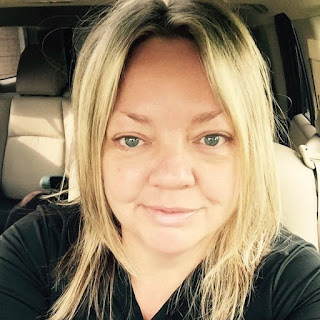 |
| Shawn Reilly Simmons |
Shawn
Reilly Simmons:
It
was both in my case—for “The Last Word” I wanted the setting to be a high end
restaurant in New York City, a location I can picture very well from my own
experiences of living and working there, and a chef who is seasoned enough to
have been through the ups and downs of a culinary career—praise, wealth,
hunger, professional jealousy, failure. Maybe it’s because I wrote this story
very quickly, but the setting and characters came to me simultaneously, I
think!
 |
| Art Taylor |
Art
Taylor:
“Better Days” is the
sequel to an earlier story that was also set on the North Carolina coast: “A
Drowning at Snow’s Cut.” To that end, characters and setting both were already
in place for the new story. But I will say that setting helped to determine to
a great degree what happens here: a coastal town, a newcomer on a big yacht,
the cocktail bar where this newcomer begins to move in on one of the local
women, and then the narrator interested in the same woman—relatively new to the
area himself and still trying to make peace with his life after having been
laid off at the big-city newspaper. Character, plot, and place come together
here in key ways.
If you had a spirit animal, what would it
be?
Kaye George:
Some
kind of beautiful bird. I’m afraid of heights and would love to be able to soar
like they do. Maybe a hawk or an eagle.
Barb
Goffman:
I
had to look up what a spirit animal is. I’ll go with the badger, whose
attributes apparently include focus on the task at hand, self-reliance,
persistence, and strategy.
Cynthia
Kuhn:
One
psychic told me that my spirit animal was a butterfly; another said it was a
giraffe. Still confused.
Shawn
Reilly Simmons:
I
had no idea so I just took an online quiz! The result: I’m a Turtle: The turtle
totem wisdom teaches us about walking our path in peace and sticking to it with
determination and serenity. Yeah, that sounds about right. While I do have a
lot on my plate, I do keep a Zen attitude about it, and am always seeking
balance in all things….I’ll take Turtle any day.
Art
Taylor:
I took two quizzes to
try to figure this one out. The first determined that my spirit animal was a
whale, because I listen to inner voices and embrace my emotions. The
second said that it should be a snake, because I’m “powerfully connected
to life force and primal energy.” Also, my sign is Pisces, and my Myers-Briggs
is INFJ. Somewhere in all that, that’s where you’ll find me.
What
shoes will you (or if you prefer, would a character from your nominated short
story) wear to the Agatha Banquet?
Kaye
George:
Hmm,
Kevin isn’t much for dressing up. He’ll probably wear leather tie shoes and
slacks, though, after I stress to him that we are being honored there. If
Vivian, the protagonist, shows up, she’ll wear low heels and a dress, I’m sure.
These are not young, stylish people, see.
Barb
Goffman:
I
wear the same shoes every year. They are black. They are flat. They are
comfortable.
Cynthia
Kuhn:
Are
flip flops allowed? If so, that would be my first choice.
Shawn
Reilly Simmons:
Most
likely something way more fancy with a higher heel than I normally wear, which
is no shoes at all when I’m writing or doing yoga, or trainers when I’m running
or lifting weights at the gym….yeah, I’ll have to acquire something more
appropriate for an elegant event!
Art
Taylor:
I’ve leaned toward
more formal or more flashy in previous years—black wingtips, white bucks, this
pair of hand-crafted blue-and-tan suede shoes from Portugal (no lie). But I’ve
got a new pair of brown Clark’s—which my wife Tara says looks like every other
shoe I wear on regular basis—and I think I’ll wear those. My character would
appreciate too: down-to-earth, nothing flashy, just who he is.
Thank
you all for taking the time to be with us and answer questions. And, many
thanks for all the wonderful stories you have written! During this time of
social distancing, it’s grand to have terrific reading material!
AUTHOR BIOS:
Kaye George:
Kaye George is a
national-bestselling, multiple-award-winning author of pre-history,
traditional, and cozy mysteries (latest is Revenge Is Sweet from Lyrical
Press). Her short stories have appeared online, in anthologies, magazines, her
own collection, her own anthology, DAY OF THE DARK, and in A MURDER OF CROWS.
She is a member of Sisters in Crime, Smoking Guns chapter, Guppies chapter,
Authors Guild of TN, Knoxville Writers Group, Austin Mystery Writers, and lives
in Knoxville, TN.
Barb Goffman:
Barb Goffman edits mysteries by
day and writes them by night. She’s won the Agatha, Macavity, and Silver
Falchion awards for her short stories, and she’s been a finalist for national
crime-writing awards twenty-eight times, including thirteen times for the
Agatha (a category record). Her work has appeared in many magazines and anthologies,
including Ellery Queen’s Mystery Magazine, Alfred
Hitchcock’s Mystery Magazine, Black Cat Mystery Magazine, and
the 2019 anthology Crime Travel, which Barb also edited. To support
her writing habit, Barb runs a freelance editing service, specializing in crime
fiction. She lives with her dog in Virginia.
Cynthia Kuhn:
Cynthia
Kuhn writes the Lila Maclean Academic Mysteries: The Semester of Our
Discontent, The Art of Vanishing, The Spirit in Question, The Subject
of Malice, and The Study of Secrets. Her work has also appeared in Mystery Most Edible, McSweeney’s
Quarterly Concern, Literary Mama, Copper Nickel, Prick of the Spindle, Mama
PhD, and other publications. Honors include an Agatha Award (best first novel),
William F. Deeck-Malice Domestic Grant, and Lefty Award nominations (best
humorous mystery). Originally from upstate New York, she lives in Colorado with
her family. For more information, please visit cynthiakuhn.net.
Shawn Reilly Simmons:
Shawn
Reilly Simmons is the author of The Red Carpet Catering Mysteries
featuring Penelope Sutherland, an on-set movie caterer, and of several
short stories appearing in a variety of anthologies including the Malice
Domestic, Best New England Crime Stories, Bouchercon, and Crime Writers’
Association series.
Shawn was born in Indiana, grew up in Florida, and began her professional
career in New York City as a sales executive after graduating from the
University of Maryland with a BA in English. Since then she has worked
as a book store manager, fiction editor, mystery convention
organizer, wine rep, and caterer. She serves on the Board of Malice Domestic
and is co-editor at Level Best Books.
Shawn is a member of Sisters in Crime, Mystery Writers of America, the
International Thriller Writers, and the Crime Writers’ Association in the
U.K.
Art Taylor:
Art Taylor is the author of the
story collection The Boy Detective & The Summer of ’74 and Other
Tales of Suspense and of the novel in stories On the Road with
Del & Louise, winner of the Agatha Award for Best First Novel. He
won the 2019 Edgar Award for Best Short Story for “English 398: Fiction
Workshop,” originally published in Ellery Queen’s Mystery Magazine,
and his other awards have included the Agatha, the Anthony, the Derringer, and
the Macavity. He is an associate professor of English at George
Mason University.
